Papers by Lillemor Lundin-olsson
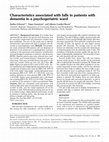
Aging Clinical and Experimental Research, 2007
Background and aims: Few studies have reported fall-risk factors for persons with dementia, and n... more Background and aims: Few studies have reported fall-risk factors for persons with dementia, and no successful randomized fall prevention studies have been published. The aim of this study was to identify characteristics associated with falls in patients with dementia in a psychogeriatric ward. Methods: This prospective study comprised 204 patients with any diagnosis of dementia. It was carried out in a psychogeriatric ward specializing in the assessment and treatment of behavioral and psychological symptoms in patients with dementia (BPSD). Baseline patient data were collected from medical records, and covered physical, behavioral and cognitive areas. Falls were recorded during time spent in the ward and median follow-up time was 52.5 days. Results: Eighty-two patients fell a total of 251 times. Factors significantly and independently associated with an increased risk of falling were male sex (IRR 3.36, 95% CI 2.02-5.61), failed "copy design" activity (decreased visual perception) (IRR 2.37, 95% CI 1.24-4.52), and any walking difficulty on level ground (IRR 1.84, 95% CI 1.10-3.08). Statins were associated with a decreased risk of falling (IRR 0.29, 95% CI 0.10-0.86). Twenty-seven percent of the variation in falls was explained. Conclusions: Male sex, decreased visual perception, and walking difficulties were all associated with an increased number of falls, and the model explained 1/4 of the variation in falls. Well-planned furnishing and use of color to achieve a plain, clearly defined environment, as well as training in walking ability, may decrease the risk of falling in people with dementia.
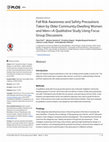
PloS one, 2015
Daily life requires frequent estimations of the risk of falling and the ability to avoid a fall. ... more Daily life requires frequent estimations of the risk of falling and the ability to avoid a fall. The objective of this study was to explore older women's and men's understanding of fall risk and their experiences with safety precautions taken to prevent falls. A qualitative study with focus group discussions was conducted. Eighteen community-dwelling people [10 women and 8 men] with and without a history of falls were purposively recruited. Participants were divided into two groups, and each group met four times. A participatory and appreciative action and reflection approach was used to guide the discussions. All discussions were audio recorded and transcribed verbatim. Data were analysed by qualitative content analysis, and categories were determined inductively. Three categories describing the process of becoming aware of fall risks in everyday life were identified: 1] Facing various feelings, 2] Recognizing one's fall risk, and 3] Taking precautions. Each category co...
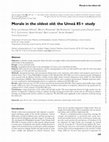
Age and Ageing, 2005
Objective: to describe morale among the oldest old, and to investigate which social, functional a... more Objective: to describe morale among the oldest old, and to investigate which social, functional and medical factors are associated with morale in this population. Design: a cross-sectional study. Setting: a population-based study in the municipality of Umeå, a city in Northern Sweden. Subjects: half of the 85-year-old population, and the total population of 90-year-olds and ≥95-year-olds (95-103) were asked to participate (n = 319) and 238 were interviewed. Methods: structured interviews and assessments during home visits, interviews with relatives and caregivers and review of medical charts. The 17-item Philadelphia Geriatric Center Morale Scale (PGCMS) was used to measure morale. Participants were assessed with the Barthel Activities of Daily Living (ADL) Index, Geriatric Depression Scale (GDS-15), Mini-Mental State Examination (MMSE), Mini Nutritional Assessment (MNA), and a symptom questionnaire. Multiple regression analyses were conducted to find independent factors to explain the variation in the PGCMS score. Results: eighty-four per cent (n = 199) of those interviewed answered the PGCMS. Three-quarters had middle range or high morale. GDS score, type of housing, previous stroke, loneliness and number of symptoms, adjusted for age group and sex, explained 49.3% of the variance of total PGCMS score. Conclusions: a large proportion of the oldest old had high morale. The most important factors for high morale were the absence of depressive symptoms, living in ordinary housing, having previously had a stroke and yet still living in ordinary housing, not feeling lonely and low number of symptoms. The PGCMS seems applicable in the evaluation of morale among the oldest old.
In this cross-disciplinary project senior citizens and researchers participated in the collaborat... more In this cross-disciplinary project senior citizens and researchers participated in the collaborative design and development of a mobile exercise application to prevent falls. The methods Form-IT an ...
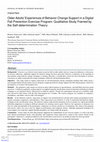
Background Exercise is an effective intervention to prevent falls in older adults; however, long-... more Background Exercise is an effective intervention to prevent falls in older adults; however, long-term adherence is often poor. To increase adherence, additional support for behavior change has been advocated. However, consistency in the reporting of interventions using behavior change techniques is lacking. Recently, a classification system has been developed to increase consistency in studies using behavior change techniques within the self-determination theory. Objective This study aimed to explore expressions of self-determination among community-dwelling older adults using a self-managed digital fall prevention exercise program comprising behavior change support (the Safe Step program), which was developed in co-creation with intended users. Methods The qualitative study design was based on open-ended responses to questionnaires, and individual and focus group interviews. A deductive qualitative content analysis was applied using the classification system of motivation and behav...
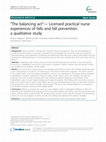
BMC Geriatrics, 2012
BackgroundFalls are common in old age and may have serious consequences. There are many strategie... more BackgroundFalls are common in old age and may have serious consequences. There are many strategies to predict and prevent falls from occurring in long-term care and hospitals. The aim of this study was to describe licensed practical nurse experiences of predicting and preventing further falls when working with patients who had experienced a fall-related fracture. Licensed practical nurses are the main caretakers that work most closely with the patients.MethodsA qualitative study of focus groups interviews and field observations was done. 15 licensed practical nurses from a rehabilitation ward and an acute ward in a hospital in northern Sweden were interviewed. Content was analyzed using qualitative content analysis.ResultsThe result of the licensed practical nurse thoughts and experiences about risk of falling and fall prevention work is represented in one theme, “the balancing act”. The theme includes three categories: “the right to decide”, “the constant watch”, and “the ongoing n...
Among elderly people, falls lead to a considerable amount of immobility, morbidity, and mortality... more Among elderly people, falls lead to a considerable amount of immobility, morbidity, and mortality. The purpose of this study was to develop and evaluate methods for predicting falls, and to evaluat ...
Allt material är skyddat genom upphovsrätten och får inte användas i kommersiellt syfte. Texten f... more Allt material är skyddat genom upphovsrätten och får inte användas i kommersiellt syfte. Texten får användas för eget bruk men källan måste anges. Källa: www.vardalinstitutet.net, Tematiska rum. Att förebygga fallolyckor bland äldre personer Den vanligaste orsaken till att äldre personer söker sjukvård för skador är att de har fallit. Fler än 75 procent har skadat sig genom att ramla, oftast när de har gått på plant underlag, medan färre än 10 procent har råkat illa ut i trafiken. Varje år dör minst 1 400 personer i Sverige efter fallolyckor och fler än 70 000 kräver sjukhusvård. Ett "fall" definieras ofta som en händelse då någon oavsiktligt hamnar på marken eller golvet oavsett om en skada inträffar eller inte. Ibland räknas inte fall pga. svimning, stroke, epilepsi och liknande; i annan statistik ingår alla fall oavsett orsak.
The aim with this study was to explore the preferences of community-dwelling older women and men ... more The aim with this study was to explore the preferences of community-dwelling older women and men regarding exercise characteristics in the context of preventing falls. Multistage focus group discus ...

Frontiers in Nutrition
This perspective aims to highlight the lack of current knowledge on sarcopenic obesity in Africa ... more This perspective aims to highlight the lack of current knowledge on sarcopenic obesity in Africa and to call for diagnostic methods and appropriate interventions. Sarcopenic obesity has been defined as obesity that occurs in combination with low muscle mass and function, which is typically evident in older adults. However, there has been no clear consensus on population-specific diagnostic criterion, which includes both gold-standard measures that can be used in a more advanced health care system, and surrogate measures that can be used in low-income settings with limited resources and funding. Importantly, low and middle-income countries (LMICs) across Africa are in an ongoing state of economic and social transition, which has contributed to an increase in the aging population, alongside the added burden of poverty, obesity, and associated co-morbidities. It is anticipated that alongside the increased prevalence of obesity, these countries will further experience an increase in age...
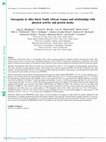
Proceedings of the Nutrition Society
IntroductionSouth Africa (SA) is a developing country with an ageing population. Adequate nutriti... more IntroductionSouth Africa (SA) is a developing country with an ageing population. Adequate nutrition and physical activity (PA) protect against the loss of muscle mass and physical function, both of which are important components of sarcopenia. This study aimed to measure the prevalence of sarcopenia in older black SA women and investigate its associations with PA and protein intake.Materials and MethodsOlder black SA women (age, 68 (range; 60–85 years) n = 122) completed sociodemographic questionnaires, 24 h urine collection (estimate protein intake), venous blood (hs-C-reactive protein (hs-CRP) and ferritin), functional tests (grip strength, 3 m timed-up-and-go (TUG), 10 m walk test) and PA monitoring (activPAL). Dual-energy x-ray absorptiometry whole-body scans assessed fat and fat-free soft tissue mass (FFSTM).ResultsAccording to the European Working group on Sarcopenia in Older People (EWGSOP)2, 2.5% (n = 3) had confirmed sarcopenia of a low severity based on normal physical fun...
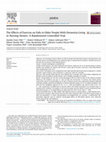
Journal of the American Medical Directors Association
Objectives: To investigate exercise effects on falls in people with dementia living in nursing ho... more Objectives: To investigate exercise effects on falls in people with dementia living in nursing homes, and whether effects were dependent on sex, dementia type, or improvement in balance. A further aim was to describe the occurrence of fall-related injuries. Design: A cluster-randomized controlled trial. Setting and Participants: The Umeå Dementia and Exercise study was set in 16 nursing homes in Umeå, Sweden and included 141 women and 45 men, a mean age of 85 years, and with a mean Mini-Mental State Examination score of 15. Intervention: Participants were randomized to the high-intensity functional exercise program or a seated attention control activity; each conducted 2-3 times per week for 4 months. Measures: Falls and fall-related injuries were followed for 12 months (after intervention completion) by blinded review of medical records. Injuries were classified according to severity. Results: During follow-up, 118 (67%) of the participants fell 473 times in total. At the interim 6-month follow-up, the incidence rate was 2.7 and 2.8 falls per person-year in exercise and control group, respectively, and at 12-month follow-up 3.0 and 3.2 falls per person-year, respectively. Negative binomial regression analyses indicated no difference in fall rate between groups at 6 or 12 months (incidence rate ratio 0.9, 95% confidence interval (CI) 0.5e1.7, P ¼ .838 and incidence rate ratio 0.9, 95% CI 0.5e1.6, P ¼ .782, respectively). No differences in exercise effects were found according to sex, dementia type, or improvement in balance. Participants in the exercise group were less likely to sustain moderate/serious fall-related injuries at 12-month follow-up (odds ratio 0.31, 95% CI 0.10e0.94, P ¼ .039). Conclusions/Implications: In older people with dementia living in nursing homes, a high-intensity functional exercise program alone did not prevent falls when compared with an attention control group. In high-risk populations, in which multimorbidity and polypharmacy are common, a multifactorial fallprevention approach may be required. Encouraging effects on fall-related injuries were observed, which merits future investigations.

Gait & Posture
How forward and backward walking, both central to everyday life, relate to cognition are relative... more How forward and backward walking, both central to everyday life, relate to cognition are relatively unexplored in people with dementia. This study aimed to investigate if forward and backward walking velocity respectively, associated with global cognition and executive function in people with dementia, and whether the association differed according to walking aid use or dementia type. Using a cross-sectional design, 161 participants (77% women), a mean Mini-Mental State Examination (MMSE) score of 15, and mean age of 85.5years and living in nursing homes were included. Self-paced forward walking (FW) and backward walking (BW) velocity over 2.4m was measured. Global cognitive outcome measurements included MMSE and Alzheimer Disease Assessment Scale - Cognitive subscale (ADAS-Cog). Executive function was measured using Verbal Fluency (VF). In comprehensively adjusted multivariate linear regression analyses, FW was independently associated with VF (p=0.001), but not MMSE (p=0.126) or ADAS-Cog (p=0.818). BW was independently associated with VF (p=0.043) and MMSE (p=0.022), but not ADAS-Cog (p=0.519). Interaction analyses showed that the association between BW velocity and executive function were stronger in participants who walked without a walking aid. No associations differed according to dementia type. In conclusion, executive function appears important to walking velocity, both forward and backward, in people with dementia with mild to moderately severe cognitive impairment. Global cognitive function was associated with backward walking only, perhaps due to it being more challenging. The association between BW velocity and executive function differed according to use of walking aids, which appeared to attenuate the association.
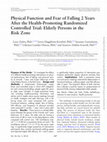
The Gerontologist, 2013
To investigate the effects of 2 different health-promoting interventions on physical performance,... more To investigate the effects of 2 different health-promoting interventions on physical performance, fear of falling, and physical activity at 3-month, 1-year, and 2-year follow-ups of the study Elderly Persons in the Risk Zone. Design and Methods: A randomized, three-armed, singleblind, and controlled study in which 459 independent and community-dwelling people aged 80 years or older were included. A single preventive home visit including health-promoting information and advice and 4 weekly senior group meetings focused on health strategies and peer learning, with a follow-up home visit, were compared with control. Functional balance, walking speed, fear of falling, falls efficacy, and frequency of physical activities were measured 3 months, 1 year, and 2 years after baseline. Results: There were no or limited differences between the groups at the 3-month and 1-year follow-ups. At 2 years, the odds ratio for having a total score of 48 or more on the Berg Balance scale compared with control was 1.80 (confidence interval 1.11-2.90) for a preventive home visit and 1.96 (confidence interval 1.21-3.17) for the senior meetings. A significantly larger proportion of intervention participants than controls maintained walking speed and reported higher falls efficacy. At 1 and 2 years, a significantly higher proportion of intervention participants performed regular physical activities than control. Implications: Both a preventive home visit and senior meetings reduced the deterioration in functional balance, walking speed, and falls efficacy after 2 years. The long-term effects of both interventions indicate a positive impact on postponement of physical frailty among independent older people.
Journal of Frailty, Sarcopenia and Falls
Early detection of older adults with an increased risk of falling could enable early onset of pre... more Early detection of older adults with an increased risk of falling could enable early onset of preventative measures. Currently used fall risk assessment tools have not proven sufficiently effective in differentiating between high and low fall risk in community-living older adults. There are a number of tests and measures available, but many timed and observation-based tools are performed on a flat floor without interaction with the surrounding. To improve falls prediction, measurements in other areas that challenge mobility in dynamic conditions and that take a persons’ own perception of steadiness into account should be further developed and evaluated as single or combined measures. The tools should be easy to apply in clinical practice or used as a self-assessment by the older adults themselves.
Journal of Frailty, Sarcopenia and Falls
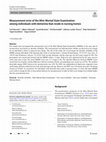
European Journal of Ageing
Few studies have investigated the measurement error of the Mini-Mental State Examination (MMSE) i... more Few studies have investigated the measurement error of the Mini-Mental State Examination (MMSE) in the same unit of measurement, also known as absolute reliability. This measurement can help determine whether an observed score change for an individual is likely to represent true change. The aim of this study was to investigate the absolute reliability of the MMSE among individuals with dementia that reside in nursing homes. Among 88 participants, 19 (21.6%) were men, 35 (39.8%) had Alzheimer’s disease, 35 (39.8%) had vascular dementia, and the mean age was 84.0 years (range 65–98). The participants were tested and retested with the MMSE within 1–6 days. Both tests were administered by the same assessor at the same time of day. The mean MMSE score was 13.7 (range 0–28). The absolute difference between MMSE scores varied from 0 to 6 points, and the differences did not correlate with the corresponding score means (p = 0.874). The smallest detectable change (SDC) between two measurement...

BMJ Open
IntroductionExercise interventions have a strong evidence base for falls prevention. However, exe... more IntroductionExercise interventions have a strong evidence base for falls prevention. However, exercise can be challenging to implement and often has limited reach and poor adherence. Digital technology provides opportunities for both increased access to the intervention and support over time. Further knowledge needs to be gained regarding the effectiveness of completely self-managed digital exercise interventions. The main objective of this study is to compare the effectiveness of a self-managed digital exercise programme, Safe Step, in combination with monthly educational videos with educational videos alone, on falls over 1 year in older community-dwelling adults.Methods and analysisA two-arm parallel randomised controlled trial will be conducted with at least 1400 community-living older adults (70+ years) who experience impaired balance. Participants will be recruited throughout Sweden with enrolment through the project website. They will be randomly allocated to either the Safe ...

Uploads
Papers by Lillemor Lundin-olsson